Plentiful sunshine is a gift of Monterey in May. These are the weeks before peak summer tourism season days really ramp up and makes driving Highway 1 south to Carmel and Big Sur a drag for local residents. And these are the weeks before the peak summer fog days of June, July and August settle over Monterey Bay as the hot temperatures of inland California attract the marine moisture of the Pacific Ocean over coastal Monterey Peninsula.
May is also Pacific harbor seal pup season around Monterey Bay. Pacific harbor seals around these parts of Central Coast California are typically born in the month of April, and spend a quick four weeks with their mother feeding on milk with 50% fat content enabling rapid body mass growth.
Pacific harbor seal pups can swim at birth and one of the entertaining observations is watching a seal pup belly-hop along the sand and into the water as mama seal attentively follows to maintain a close watch on her pup. Maternal attention is relatively short-lived as young pups are weaned and independent within about four weeks of birth. Research indicates there is minimal social bonding activity between a harbor seal mom and her offspring after the first month of togetherness.
While Pacific harbor seals vocalize under water, there is minimal vocalization out of water, except during pupping season. Seal pups are vocal and mama pups are vocal when they want to be left alone or another seal pup or adult gets too close. Unlike California Sea lions, which typically are seen huddled together in large groups, even climbing over each other to find their comfortable space, Pacific harbor seals appear to not want to be touched by other seals when they are on land. They generally maintain several feet or at least a few inches of personal space from other seals.
There are estimated to be 500 to 700 Pacific harbor seals around the Monterey Peninsula, which includes Monterey, Pacific Grove, Pebble Beach, Carmel and Point Lobos State Reserve. There are about 35,000 Pacific harbor seals along the coast of California with the Channel Islands holding the largest population followed by Point Reyes National Seashore north of San Francisco.
A drive seven miles south on Highway 1 puts me at the gate of Point Lobos State Reserve, the so-called ‘Crown Jewel’ of the California State Parks System. I park off Highway 1 and hike into the park on average every week or two throughout the year. January and February for gray whale migration season and April-May for Pacific harbor seal pup season generally means more frequent visits to Point Lobos.

Pacific Harbor Seal Pups at Whalers Cove, Point Lobos
A small beach at Whalers Cove in Point Lobos State Reserve is one of the best locations around the Monterey Peninsula to observe Pacific harbor seal pups at relatively close proximity. There were six to eight harbor seal pups I could see from the road along Whalers Cove. In years past I have seen as many as two dozen seal pups on this beach.
Here are some Pacific harbor seal photos from May 2, 2019 taken at Point Lobos State Reserve.
[click on images to enlarge]
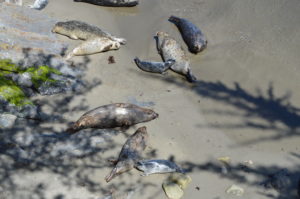
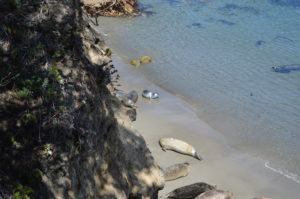
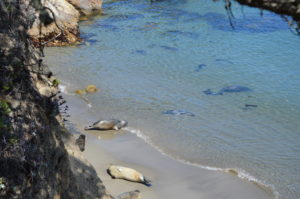
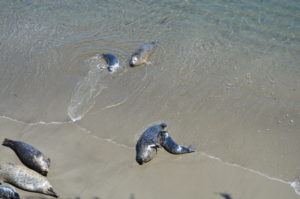
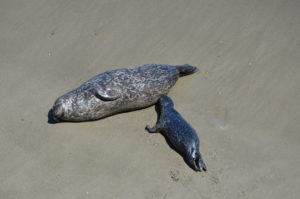
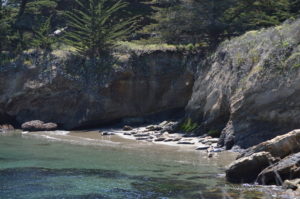
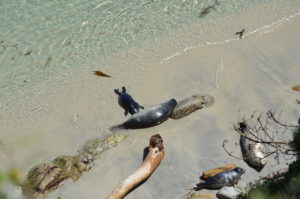
A couple minutes later this pup was riding in the water holding on to mom’s back.
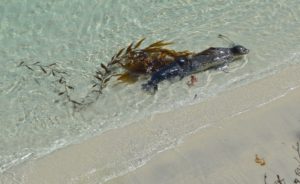
The first photo in this piece is a view across Bluefish Cove and below is a 60-second panoramic video of Bluefish Cove.
Sea Otters at Point Lobos State Reserve
There are usually a couple of sea otters to be seen in Cypress Cove, Point Lobos. There are at least three sea otters in this photo and looks like there is a fourth otter, possibly a pup by the otter in the seaweed patch. Sea otter moms often leave their pups wrapped in sea otter while they dive for food. I failed to observe them with binoculars to determine if there was an otter pup.

[Tourist Tip: One of the best places around Monterey Bay for observing sea otters up close is Moss Landing inner harbor. There are often 30 or more sea otters hanging out and easily visible from the road at Moss Landing State Beach at the inner harbor just north of the PGE facility (two tall towers) once you cross over the bridge. Keep in mind that if you are in a kayak, federal regulations require you to maintain your distance to not interfere with the sea otter. Several times each year I watch tourists get too close to our local sea otters.]
I hiked along the Allen Memorial Grove trail at Point Lobos to the westernmost point of the park accessible by land in hopes of spotting gray whales migrating north from Mexico to Alaska. Checking the Palos Verdes gray whale census indicates most of the gray whales headed north 5 to 7 weeks ago. Seems like this year the gray whales headed south to Mexico later than usual this season with peak migration in February and then headed north again almost immediately with peak migration in March. Perhaps the best indicator from the ACS census is the number of gray whales sighted this season and last season is well above the average sightings for the past ten years.
Within minutes after arriving on the rocks at the Pinnacle Cove lookout spot in Point Lobos (Allen Memorial Cypress Grove trail), a young woman asked me if I had spotted any whales. I had not seen any blow on the water.
Gray whales rarely come near the shoreline rocks. Most sightings are about half a mile or more from the coastline and without binoculars all a person usually sees from the shoreline is blow spray when the gray whale surfaces to breathe resulting in a visible spray of water emanating from the sea surface. Once blow has been sighted, then tracking the whale is simply a matter of watching for the next blow along a line either north or south depending on the migration direction.
There have been a few times I’ve seen gray whales hang about in one location around here for 15 to 30 minutes, but generally I simply see gray whales swimming by from my vantage point along the shore moving at a fairly steady pace of 4 to 5 miles per hour. Once a whale or a small pod of whales are spotted by their blow, then in good weather conditions they are usually visible for 20 to 30 minutes by their blow spray.
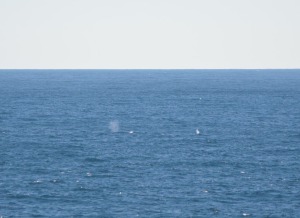
I provided a quick educational lesson to the woman about gray whale behavior as we both watched for blow on the water. The main point I wanted to impart is sighting whales at Point Lobos is a hit or miss opportunity. There have been many times I spotted whales within a couple of minutes of reaching the western rocks on the edge of the Pacific and then sat for an hour with no more sightings. There have been many times when I saw no whales at all. One February afternoon this season I spotted more than a dozen gray whales heading south over the 90 minutes I watched from Sea Lion Point.
After a few minutes the inquisitive woman headed off with her friend around the trail as I kept gazing out to sea in hope of spotting some whale blow. Yesterday was a bust for gray whale sightings at Point Lobos during my hour watching the sea.
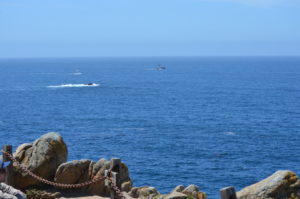
Two fishing boats passed by Pinnacle Cove. I had noticed an unusually high number of seagulls swarming over Carmel Bay as I hiked across Point Lobos out to the point for whale spotting. A large presence of seagulls is an indicator of concentrated fish activity in the bay. I had not seen any fishing boats in Carmel Bay.
A couple minutes later I saw a large splash in the water about a mile or more from shore to the northwest. That splash of water was followed by another. And another. Unsure if there was a boat out there, my binoculars sighted the fluke of a humpback descending into the water.
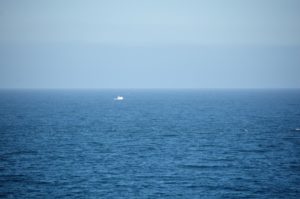
Over the next two or three minutes I watched humpback whales in two locations leaping out of the sea and crashing back down on the surface with tremendous splashes of water.
My camera lens was not powerful enough to capture the spectacle from that distance, but my binoculars provided the evidence I needed for a confirmation and a strong visual memory.
I spotted the woman and her friend still hanging around on the outer rocks trail and walked over to ask if they had noticed the whale activity. There were six people standing there taking photos and none had noticed the whales breaching for several minutes. For about the next ten minutes we all watched the two locations where humpbacks were leaping out of the water about every minute or two as evidenced by sudden splashes of whitewater on the ocean surface.

My photographic evidence of whale activity is underwhelming. With the naked eye the shoreline observer can barely make out the actual whale since the whales are generally a half mile or more away. Binoculars are a necessity for whale viewing from the coast and even better is a spotting scope, a possession I would love to have one day to help my viewing pleasure with all the hours I invest watching for whales each year.
Yet visitors to Point Lobos are always entranced gazing out to sea when I point out whale activity. Most people have had very few opportunities to see a whale in the wild. Even without the aide of binoculars or a high powered camera lens, visitors to Point Lobos seem fascinated and thankful to know they are in the presence of the world’s largest living animals. I know I appreciate the natural wonders of sea life in Monterey after so much time spent in other coastal areas of the world with barely a sign of marine mammal sea life visible from the shore.
Monterey Bay is a popular place for whale watching cruises if you really want to get up close. Even though I have the opportunity to take a whale watching cruise into Monterey Bay most any day of the year for $30 to $35, I have only been on a Monterey Bay whale watching cruise once. While I enjoyed the opportunity to photograph whales up close, I personally was upset by the experience of seeing several boats chasing whales around Monterey Bay. I don’t need to be on top of the whales. There are plenty of opportunities to be around whales without intruding on their domain, while casually observing them from the shoreline.
Marine Mammal Center – Pacific Harbor Seals
Point Lobos State Reserve (California State Parks website)
American Cetacean Society Los Angeles Chapter – Gray Whale Census
I have posted dozens of articles about Point Lobos, whales, seals, otters and our local communities. Here are links to article tags for pieces I have written in the past 12 years. There is plenty of useful local information for a tourist in these articles about Monterey Peninsula hotels, events, sights and wildlife if you have plans to visit the area.
Moss Landing (mostly wildlife articles)
Big Sur (this link pulls up several Big Sur road trip sights, hotel reviews and wildlife photos)
whales (two of the best whale sightings for photos when several humpback whales were less than 200 yards away from shore were Moss Landing State Beach July 2014 and Point Lobos August 2015).



1 Comment
Comments are closed.